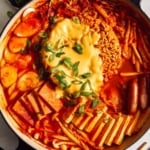Budae Jjigae (Korean Army Stew)
A delicious Korean stew originally created post Korean war due to necessity and limited resources, Budae Jjigae is enjoyed today by many as an inexpensive kitchen sink type Korean stew with deep, rich flavors.
Servings: 6
Calories: 267kcal
Ingredients
sauce paste
- 2 1/2 tablespoons gochujang (Korean hot pepper paste )
- 2 tablespoons water
- 1 1/2 tablespoons gochugaru (Korean hot pepper flakes)
- 2 tablespoons minced garlic
- 1 tablespoon soy sauce
- 1 1/2 teaspoons sugar
stew
- 7 ounces drained firm tofu cut into thin squares
- 6 ounces (1/2 can) Spam cut into thin squares
- 6 mini sausages such as lil smokies
- 1 cup chopped green cabbage
- 1/2 pound tteok (oval shaped rice cakes)
- 5 ounces enoki or snow white mushrooms, trimmed
- 5 cups water
- 1 pack instant ramen noodles (without flavor packet)
- 2 slices American cheese
- 2 green onions thinly sliced on a bias
Instructions
- Place all paste ingredients into a small bowl.
- Whisk together. Set aside.
- In a large, shallow pot arrange sausages, spam, tofu, cabbage, rice cakes, and mushrooms.
- Top with paste mixture.
- Pour water in pot and bring to a boil. Gently stir to evenly distribute the paste.
- Once mixture is brought to a boil, add noodles, and continue to cook until everything has cooked through, and noodles are soft.
- Top stew with American cheese and green onions and boil for another minute. Remove from heat and serve.
Notes
Tips and Tricks for Success
- The spicy paste sets the foundation for the overall stew, so you don't want to skimp on the ingredients. It's especially important to use gochujang for the authentic (slightly) sweet and spicy umami flavor it provides. (If you're interested to learn more about gochujang and my preferred brands you can find more information in our Gochujang Noodles recipe post.)
- Keep things cheap and simple, like the dish was originally intended to be. It will truly give you the best flavor and experience!
- Eat it immediately after making it to ensure the noodles and rice cakes don't bloat and become soggy.
Nutrition
Calories: 267kcal | Carbohydrates: 39g | Protein: 14g | Fat: 16g | Saturated Fat: 6g | Polyunsaturated Fat: 2g | Monounsaturated Fat: 7g | Trans Fat: 0.1g | Cholesterol: 33mg | Sodium: 1159mg | Potassium: 363mg | Fiber: 2g | Sugar: 3g | Vitamin A: 726IU | Vitamin C: 7mg | Calcium: 147mg | Iron: 2mg
